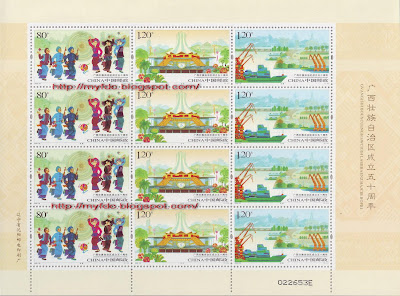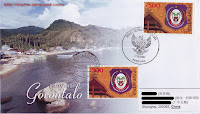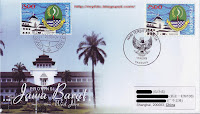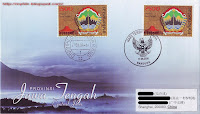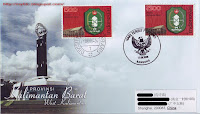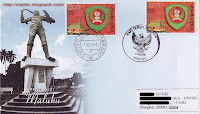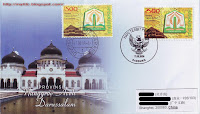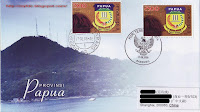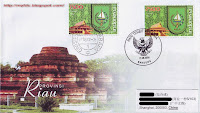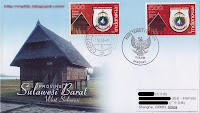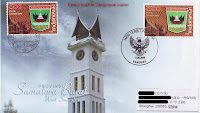
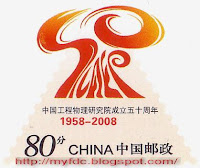 China Pre-stamped Postcard
China Pre-stamped Postcard
Name: 50th Anniversary of China Academy of Engineering Physics
Number: JP152
Date of Issue: 28 October 2008
China Academy of Engineering Physics (CAEP) (Chinese: 中国工程物理研究院) is founded in October, 1958. It is the research and manufacturing center of Chinese nuclear weapons.
CAEP was initially located in Beijing. Its major departments were later relocated to Qinghai Province. In 1970, the major components moved to Sichuan Province. The Academy was formerly named Ninth Institute of Second Ministry of Mechanical Industry, and Ninth Institute of Ministry of Nuclear Industry. It was later renamed CAEP. In China, the Ninth Institute is still well recognized.
Its headquarter is located in the 839 area of Mianyang, which covers a land area of 5 sq. km. It's nicknamed Scientific Town. It has multiple branches in Beijing, Jiangyou, Chengdu and Shanghai. More...
Friday, October 31, 2008
China Pre-stamped Postcard JP152
Posted by Fan Ming at 10/31/2008 06:57:00 PM
![]() 0
Comments
Label:
China
0
Comments
Label:
China
Thailand Provincial Emblems FDCs-2
Thailand FDCs
Name: Provincial Emblems (3rd Series)
Date of Issue: 10 October 2008
Number: 856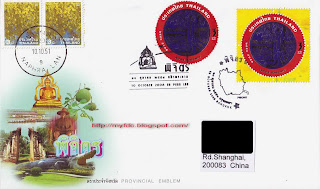 Phichit
Phichit
Phichit (Thai: พิจิตร) is one of the provinces (changwat) of Thailand, located in the north of the country. Neighboring provinces are (from north clockwise) Phitsanulok, Phetchabun, Nakhon Sawan and Kamphaeng Phet.
The provincial seal shows a pond, which refers to the old name of Phichit, Mueang Sra Luang (meaning city at the royal pond). The Banyan tree in front refers to the temple Wat Pho Prathab Chang. The temple was built in 1669-71 by King Luang Sorasak, who was born in the village of Pho Prathab Chang, between a Banyan and a Sacred Fig. More...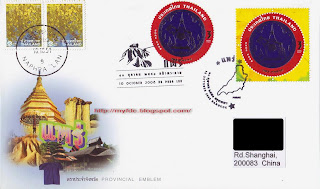 Phitsanulok
Phitsanulok
Phitsanulok (Thai: พิษณุโลก) is one of the provinces (changwat) of Thailand, located in the North of Thailand. Neighboring provinces are (from east clockwise) Loei, Phetchabun, Phichit, Kamphaeng Phet, Sukhothai, Uttaradit. In the north-east it also has a short border with Xaignabouli of Laos.
The seal of the province shows the Buddha Chinnarat, which is considered one of the most beautiful Buddha figures in Thailand. It is located in Wat Mahathat temple in the city Phitsanulok. More... Phetchaburi
Phetchaburi
Phetchaburi (often short Phet'buri, Thai: เพชรบุรี) is one of the central provinces (changwat) of Thailand. Neighboring provinces are (from north clockwise) Ratchaburi, Samut Songkhram and Prachuap Khiri Khan. In the west it borders Tanintharyi Division of Myanmar.
The provincial seal shows the Khao Wang palace in the background. In front are rice fields bordered by two palm tree, symbolizing the major crops in the province. More... Phetchabun
Phetchabun
Phetchabun (Thai: เพชรบูรณ์) is one of the northern provinces (changwat) of Thailand. Neighboring provinces are (from north clockwise) Loei, Khon Kaen, Chaiyaphum, Lopburi, Nakhon Sawan, Phichit and Phitsanulok.
The provincial seal show a diamond on a mountain, as diamonds are found in the province. In the front are tobacco plants as one of the crops grown in the province. More...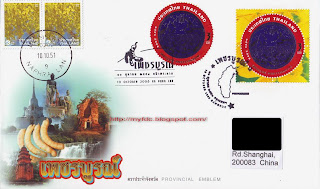 Phrae
Phrae
Phrae (Thai: แพร่) is one of the northern provinces (changwat) of Thailand. Neighboring provinces are (from north clockwise) Phayao, Nan, Uttaradit, Sukhothai and Lampang.
According to legend the two cities of Phrae and Nan were once ruled by brothers. When they met to divide the land between them the one from Phrae rode on a horse, the one from Nan on a buffalo to the meeting point on top of a mountain. Hence Phrae uses a horse in their seal, while Nan uses a buffalo. When the provincial government proposed the seal in 1940, the Fine Arts Department suggested to add some historic building to the seal additional to the horse, thus it now have the pagoda of Phra Tat Cho Hae on the back of the horse. This temple is located about 9 kilometers south-east of the city Phrae. More...
2007 Thailand Provincial Emblems FDCs: (1st Series)
(Part I), (Part II), (Part III), (Part IV)
2007 Thailand Provincial Emblems Sheetlet FDCs: (1st Series)
(Part I), (Part II)
2008 Thailand Provincial Emblems FDCs: (2nd Series)
(Part I), (Part II)
2008 Thailand Provincial Emblems Sheetlet FDC (2nd Series)
2008 Thailand Provincial Emblems FDCs: (3rd Series)
(Part I), (Part II)
2009 Thailand Provincial Emblems FDCs: (4th Series)
(Part I), (Part II)
Posted by Fan Ming at 10/31/2008 07:24:00 AM
![]() 0
Comments
Label:
Thailand
0
Comments
Label:
Thailand
Thursday, October 30, 2008
Thailand Provincial Emblems FDCs-1
Thailand FDCs
Name: Provincial Emblems (3rd Series)
Date of Issue: 10 October 2008
Number: 856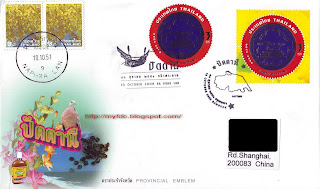 Pattani
Pattani
Pattani (Thai ปัตตานี) is one of the southern provinces (changwat) of Thailand. Neighboring provinces are (from south-east clockwise) Narathiwat, Yala and Songkhla.
The seal of the province shows the cannon called Phraya Tani, which was cast in the Pattani province. It was brought to Bangkok in 1785, and is now on display in front of the Ministry of Defence in Bangkok. More...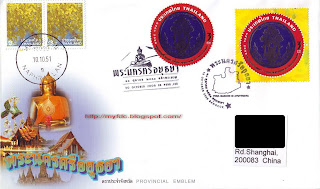 Phra Nakhon Si Ayutthaya
Phra Nakhon Si Ayutthaya
Ayutthaya (full name Phra Nakhon Si Ayutthaya, Thai: พระนครศรีอยุธยา, pronounced eye-you-TEE-a) is one of the central provinces (changwat) of Thailand. Neighboring provinces are (from north clockwise) Ang Thong, Lop Buri, Saraburi, Pathum Thani, Nonthaburi, Nakhon Pathom and Suphan Buri.
According to legend King Ramathibodi I found a beautiful conch buried in the ground, and chose the site as the place for his future capital. He then placed the conch on a pedestral tray and built a pavilion around it. The seal shows this pavilion with the provincial tree behind it. More...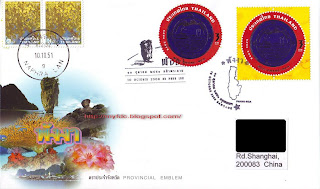 Phang Nga
Phang Nga
Phang Nga (Thai: พังงา) is one of the southern provinces (changwat) of Thailand, on the shore to the Andaman Sea. Neighboring provinces are (from north clockwise) Ranong, Surat Thani and Krabi. To the south is the Phuket province, but without land boundary to Phang Nga.
The seal shows the Phu Khao Chang mountains in the background, and the City Hall in front. It also shows a dredge to represent the tin mining in the province. More...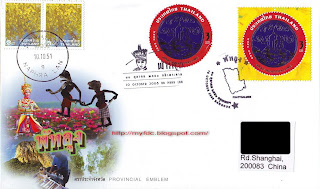 Phatthalung
Phatthalung
Phatthalung (Thai: พัทลุง) is one of the southern provinces (changwat) of Thailand. Neighboring provinces are (from north clockwise) Nakhon Si Thammarat, Songkhla, Satun and Trang.
The provincial seal shows the 250 meter high Phu Khao Ok Thalu mountain, the symbol of the province. More...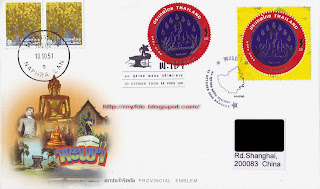 Phayao
Phayao
Phayao (Thai พะเยา) is one of the northern provinces (changwat) of Thailand. Neighboring provinces are (from east clockwise) Nan, Phrae, Lampang and Chiang Rai. In the north-east it borders Xaignabouli of Laos.
The provincial seal shows Buddha, representing the famous Buddha image in the temple Wat Si Khom Kham called Phra Chao Ton Luang. Behind him are 7 flames showing the glory of Buddha. In front of Buddha is a bowl and two ears of rice. More...
2007 Thailand Provincial Emblems FDCs: (1st Series)
(Part I), (Part II), (Part III), (Part IV)
2007 Thailand Provincial Emblems Sheetlet FDCs: (1st Series)
(Part I), (Part II)
2008 Thailand Provincial Emblems FDCs: (2nd Series)
(Part I), (Part II)
2008 Thailand Provincial Emblems Sheetlet FDC (2nd Series)
2008 Thailand Provincial Emblems FDCs: (3rd Series)
(Part I), (Part II)
2009 Thailand Provincial Emblems FDCs: (4th Series)
(Part I), (Part II)
Posted by Fan Ming at 10/30/2008 07:19:00 AM
![]() 0
Comments
Label:
Thailand
0
Comments
Label:
Thailand
Wednesday, October 29, 2008
Germany Sky Disk FDC
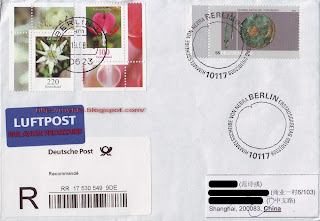 Germany FDC
Germany FDC
Name: Nebra Sky Disk
Date of Issue: 09 October 2008
The Nebra sky disk is a bronze disk of around 30 cm diameter, patinated blue-green and inlaid with gold symbols. These are interpreted generally as a sun or full moon, a lunar crescent, and stars (including a cluster interpreted as the Pleiades). Two golden arcs along the sides, marking the angle between the solstices, were added later. A final addition was another arc at the bottom surrounded with multiple strokes (of uncertain meaning, variously interpreted as a Solar Barge with numerous oars, as the Milky Way or as a rainbow).
The disk is attributed to a site near Nebra, Saxony-Anhalt in Germany, and associatively dated to c. 1600 BC. It has been associated with the Bronze Age Unetice culture.
The disk is unlike any known artistic style from the period, and had initially been suspected of being a forgery, but is now widely accepted as authentic. More...
Comment: It might be more beautiful and intuitive if this stamp had used in letterpress printing. I don't know whether my opinion is correct, Deutsche Post (Germany Post) seldom uses special printing technology in their stamps.
Posted by Fan Ming at 10/29/2008 07:14:00 AM
![]() 0
Comments
Label:
Germany
0
Comments
Label:
Germany
Tuesday, October 28, 2008
Germany Hans Grade FDC
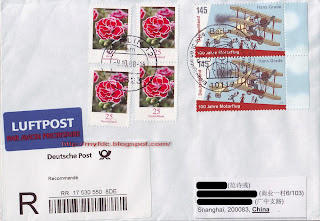 Germany FDC
Germany FDC
Name: 100 Years of First Powered Flight in Germany - Hans Grade
Date of Issue: 09 October 2008
Hans Grade was an engineer and a german aviation-pioneer. On the 28th of October 1908 he successfully conducted the first motor-flight over german soil in a motorised aircraft of his own construction at Magdeburg. More...
Comment: This is a double-First Day Cover, not only the commemorative stamp but also the definitive stamps (Carnation) were all new issue on 09 October, 2008. But it has a big problem on this FDC, the postage was overpaid. the correct registered postage from Germany to China is 3.75 euro, and it has 3.90 euro on this FDC. What a pity!
Posted by Fan Ming at 10/28/2008 07:30:00 AM
![]() 0
Comments
Label:
Germany
0
Comments
Label:
Germany
Monday, October 27, 2008
Indonesia Post Road S/S FDC
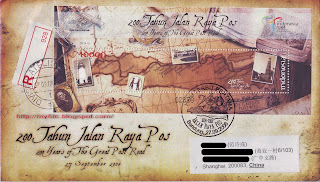
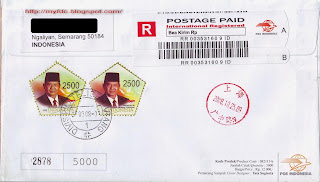 Indonesia Souvenir Sheet FDC
Indonesia Souvenir Sheet FDC
Name: 200 Years of The Great Post Road
Date of Issue: 27 September 2008
The Great Post Road is the road stretched from west to east at northern part of Java from Anyer to Panarukan along 1,000 km. Initiated by Governor-General Herman Willem Daendels, this road is passing through Serang, Tangerang, Jakarta, Bogor, Sukabumi, Cianjur, Bandung, Sumedang, Cirebon, Brebes, Tegal, Pemalang, Pekalongan, Kendal, Semarang, Denak, Kudus, Rembang, Tuban, Gresik, Surabaya, Sidoarjo, Pasuruan, Probolinggo and Situbondo.
Daendels was a marshal appointed as governor general of East Indies by Lodewijk Napoleon who ruling Holland at that time. The ultimate aim was handling military preparation in anticipating British navy attack that had blockaded Java Island. Daendels landed in Anyer in 1808 after routing a long trip from Cadiz in southern Spain, Canary Islands and then departing from New York using American vessel.
Daendels's most important military project in defending Java from British attack was constructing a highway connecting west and east corner of this island. The road was built by means of obliging indigenous rulers to mobilize people along the route to work it by force. This road had sacrificed thousands life in nearly a year of its building process. Later, the road was renowned as the Great Post Road (De Goote Postweg) since Daendels also set off post and telegraph services at the moment of the making.
Since its operation in 1809, the road formerly intended for military purpose had become a main transportation infrastructure in Java Island. This highway had witnessed traffic of commodities conveyed over it since colonial era till now. The road has play important role as one of crucial veins of Indonesian economy today.
Comment: Cheer! Pos Indonesia (Indonesia Post) has started to use barcode registered label. I guess it was glued in the transit post office instead of the local post office.
2008 Indonesia 200 Years of The Great Post Road
Stamps FDC, Souvenir Sheet FDC
Posted by Fan Ming at 10/27/2008 07:11:00 AM
![]() 0
Comments
Label:
Indonesia
0
Comments
Label:
Indonesia
Saturday, October 25, 2008
Indonesia Post Road FDC
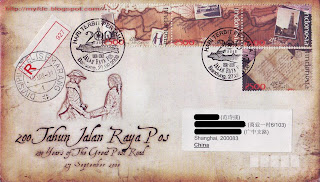
 Indonesia FDC
Indonesia FDC
Name: 200 Years of The Great Post Road
Date of Issue: 27 September 2008
Denominations:
1/4 Rp2500: West Java Map
2/4 Rp2500: Central Java Map
3/4 Rp2500: East Java Map
4/4 Rp2500: Daendels Document
The Great Post Road is the road stretched from west to east at northern part of Java from Anyer to Panarukan along 1,000 km. Initiated by Governor-General Herman Willem Daendels, this road is passing through Serang, Tangerang, Jakarta, Bogor, Sukabumi, Cianjur, Bandung, Sumedang, Cirebon, Brebes, Tegal, Pemalang, Pekalongan, Kendal, Semarang, Denak, Kudus, Rembang, Tuban, Gresik, Surabaya, Sidoarjo, Pasuruan, Probolinggo and Situbondo.
Daendels was a marshal appointed as governor general of East Indies by Lodewijk Napoleon who ruling Holland at that time. The ultimate aim was handling military preparation in anticipating British navy attack that had blockaded Java Island. Daendels landed in Anyer in 1808 after routing a long trip from Cadiz in southern Spain, Canary Islands and then departing from New York using American vessel.
Daendels's most important military project in defending Java from British attack was constructing a highway connecting west and east corner of this island. The road was built by means of obliging indigenous rulers to mobilize people along the route to work it by force. This road had sacrificed thousands life in nearly a year of its building process. Later, the road was renowned as the Great Post Road (De Goote Postweg) since Daendels also set off post and telegraph services at the moment of the making.
Since its operation in 1809, the road formerly intended for military purpose had become a main transportation infrastructure in Java Island. This highway had witnessed traffic of commodities conveyed over it since colonial era till now. The road has play important role as one of crucial veins of Indonesian economy today.
Comment: The Daendels Document (4/4 stamp) is about appointment of Raksa Manggala as a Head of Bengawan Wetan, Cirebon region by Governor General Daendels. The aim of this appointment is to succeed the development of The Great Post Road. The document's date is 18 April 1809. this document is a property of Puji Harsono.
2008 Indonesia 200 Years of The Great Post Road
Stamps FDC, Souvenir Sheet FDC
Posted by Fan Ming at 10/25/2008 09:59:00 PM
![]() 0
Comments
Label:
Indonesia
0
Comments
Label:
Indonesia
China Sheetlet: 2008-27
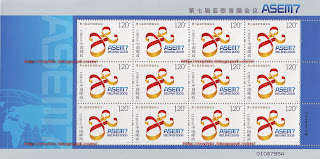 China Sheetlet
China Sheetlet
Name: The 7th Asia-Europe Meeting
Number: 2008-27
Date of Issue: 24 October 2008
Value: 12 stamps/sheet
The Asia-Europe Meeting (ASEM) was officially established in 1996 at the first summit in Bangkok. ASEM is an interregional forum which consists of the European Commission, the twenty-seven members of the European Union (EU), the thirteen members of the ASEAN Plus Three regional grouping, and, as of 2008, India, Mongolia, and Pakistan. More...
The Seventh Asia-Europe Meeting (ASEM 7) will be held in Beijing 24-25 October 2008. The summit will be the first gathering of leaders of 45 ASEM partners since its second round of enlargement in 2006.
The overarching theme of ASEM7 is 'Vision and Action: Towards a Win-Win Solution'. At the summit ASEM leaders will focus their discussions on political, economic and social and cultural issues, including issues related to sustainable development. The Summit will provide a good opportunity for expanding and deepening dialogue on an equal footing and mutually-beneficial cooperation between Asia and Europe to ensure win-win progress for the benefit of peoples of ASEM partners.
Official Website of the ASEM7
Posted by Fan Ming at 10/25/2008 12:14:00 PM
![]() 0
Comments
Label:
China
0
Comments
Label:
China
Thursday, October 23, 2008
Sri Lanka History FDC
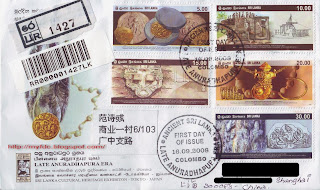
 Sri Lanka FDC
Sri Lanka FDC
Name: Ancient Sri Lanka – Late Anuradhapura Era
Issue date: 16 September 2008
Anuradhapura, (அனுராதபுரம் in Tamil), is one of the ancient capitals of Sri Lanka, famous for its well-preserved ruins of ancient Lankan civilization.
The city, now a UNESCO World Heritage Site, lies 205 km north of the current capital Colombo in Sri Lanka's North Central Province, on the banks of the historic Malvathu Oya.
Founded in the 4th century BC, it was the capital of the Anuradhapura Kingdom until the beginning of the 11th century AD. During this period it remained one of the most stable and durable centers of political power and urban life in South Asia. The ancient city, considered sacred to the Buddhist world, is today surrounded by monasteries covering an area of over sixteen square miles (40 km²). Anuradhapura is also significant in Hindu legend as the fabled capital of the Asura King Ravana in the Ramayana. More...
Denominations:
5.00: Ancient Sophisticated Technology and Technique: Middle age Gold Coin, its mould and gold ingot used for manufacturing gold coin
Ran Kahavanu is type of coin used in Ceylon from 8th century AD to the 11th century AD. Half of the Kahavanu (1/2) was identified as "Half Kahavanu" and (1/4) quarter of the Kahavanu was identified as "Deaka Alias Palaya" and 1/8 of the coin was identified as "Aka" Information gathered reveal that the "Aka" coin had been in use up to almost the 15th century. Doubts have been raised with regard to symbols and notes on the obverse and reverse of the coins. The date of issue and the name of the king are not indicated in any of the coins. The coins have been manufactured by pouring melted gold into a clay mould made in the form of two lids.
Several lumps of gold recovered at the Abhayagiriya excavations are identified as "Gold tablets" (Swarna Palaka Pinda).
The weight has been indicated in the coins. The recovery of twenty two gold coins along with five "Swarna Palaka Pinda" (Gold Tablets) makes one believe that these lumps had been used in the manufacture of gold coins.
10.00: Architecture: Medirigiriya, Vatadageya and its conjectural drawing
The Medirigiriya Viharaya has been a prominent Buddhist Sangarama in existence from the early Anuradhapura period. The most ancient source of information relating to Medirigiriya is the Mahavamsa indication that King Kanittatissa built a Simamalaka for the Mandalagiri Viharaya in 2nd century AD (167-186AD) mention is also made that in 7the century AD. During the reign of King Agrabodhi IV a person named Malayarasa had erected an attractive Watadage for the stupa which existed there. This Watadage had been renovated by several kings who reigned later. It is also revealed that the Mandalagiri Viharaya had been a significant Buddhist centre up to 13th century AD.
The most glorious architectural construction is this Vihara complex is considered to be the Vatadageya. The Watadegeya erected on an elevated circular dais, encircling the smaller stupas, gains prominence as an excellent architectural structure among all other Watadageyas in existence. This stamp depicts the remnants of this Watadage, and a creative design of the original nature of the Watadage, determine after an extensive study.
15.00: Sanitation, Living standard and Conservation of Environment: Urinal stone at Western Monasteries in Anuradhapura and cross section of Sanitary system
This is a urinal stone belonging to the western monastery 'Padhanagara' Complex reserved for Pansakulika monks. In this Padhanagara complex, the only art of carving is the urinal stone scholars are of the view that these carvings made only on the urinal stone reflects the view that all worldly possessions should be shunned or treated with contempt.
The Pit of the Urinal stone is formed by placing three large terra-cotta pots placed one on top of another. The urine is filtered through the fillings in the pots and ultimately drains on the soil as pure water. The priority placed in such ancient times on Health and Sanitation and the technology used can be considered as superb.
20.00: Jewellery: Bangle, Necklace with a Pendent, Anklet and Teerracotta beads Necklace
The jewellery recovered at Abhayagiriya is fabulous creations which portray the expertise in jewellery manufacturing. A necklace with a pendant, a bangle and foot ornaments are included. The fine and delicate carvings herein depicts the excellent creative ability of the sculptor. The necklace is made of gold thread.
The necklace adorned with clay heads shown in the background, was gathered from the Jetawana Vihara complex. All these belong to the post Anuradhapura period.
30.00: Art & Sculpture: Bodhisatva Vajrapani and Avalokithesvara at Buduruwagala and Sculpture of Royal Family at Isurumuniya
The Buduruvagala Bodhisatva Statue carved on a mountain, remains an exemplary carving among the Mahayana statues in Sri Lanka. The present remnants provide evidence that the statue was plastered and stained later. Depicted here are the Avalokatheshwara Maithriya and Wajrapani Bodhisatva triad in existence among other statues. The statues are considered to be belonging to the 8th-9th centuries AD.
The carved tabled identified as the 'Royal Family' at present exhibited at the Isurumuniya Vihara Museum, originally said to have been in the Ranmasu Uyana is a superb piece of carving in the Island. These carvings depicting the Gupta style of sculpture are extremely charming. Professor Senarath Paranavithana is of opinion that the carving portrays King Dutugemunu with his queen in conversation with Saliya - Asokamala in the palace of prince Saliya.
Comment: Jesus! Too many strange words in this article, so it's hard to understand it clearly. How about your feeling?
Ancient Sri Lanka Series FDCs:
2nd Series: Proto - Historic Era & Early Anuradhapura Era
3rd Series: Late Anuradhapura Era
Posted by Fan Ming at 10/23/2008 07:23:00 AM
![]() 1 Comments
Label:
Sri Lanka
1 Comments
Label:
Sri Lanka
Wednesday, October 22, 2008
China Stamp: 2008-27
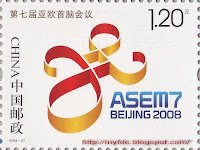 China Stamp
China Stamp
Name: The 7th Asia-Europe Meeting
Number: 2008-27
Date of Issue: 24 October 2008
Value: 1 stamp/set
The Asia-Europe Meeting (ASEM) was officially established in 1996 at the first summit in Bangkok. ASEM is an interregional forum which consists of the European Commission, the twenty-seven members of the European Union (EU), the thirteen members of the ASEAN Plus Three regional grouping, and, as of 2008, India, Mongolia, and Pakistan. More...
The Seventh Asia-Europe Meeting (ASEM 7) will be held in Beijing 24-25 October 2008. The summit will be the first gathering of leaders of 45 ASEM partners since its second round of enlargement in 2006.
The overarching theme of ASEM7 is 'Vision and Action: Towards a Win-Win Solution'. At the summit ASEM leaders will focus their discussions on political, economic and social and cultural issues, including issues related to sustainable development. The Summit will provide a good opportunity for expanding and deepening dialogue on an equal footing and mutually-beneficial cooperation between Asia and Europe to ensure win-win progress for the benefit of peoples of ASEM partners.
Official Website of the ASEM7
Posted by Fan Ming at 10/22/2008 01:59:00 PM
![]() 0
Comments
Label:
China
0
Comments
Label:
China
Malaysia Flowers S/S FDC
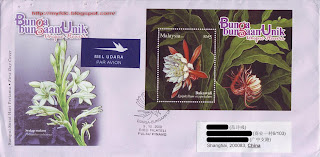

Malaysia Souvenir Sheet FDC
Name: Unique Flowers
Date of Issue: 09 October 2008
There are many varieties of flowers found in Malaysia and there are some species that are attractive and unique due to their special shape or rare fragrance. Most traditional Malay landscape comprise of plants with fragrant flowers, leaves and wood. In fact, most traditional poetry refers to these unique traits.
The issuance of this Unique Flower stamps is an effort to increase the awareness of such flowers as well as to popularize Malaysian flowers
Denominations:
RM5: Gooseneck Cactus (Epiphyllum oxypetalum)
A slender herb, under the family of cactaceae grows up to 1 – 2 meter. It has a short main stem and long irregular branches that are flat and look like leaves that are jointed with edges that are scalloped, green or slightly brownish, about 6 – 10 cm wide, 25 – 45 cm long.
The large white flowers are nocturnal, vary fragrant, with 20 – 25 cm, slender, curved red tubes and with red to yellow sepal, and numerous white linear or ovate petals. The white stamens are numerous and the style is yellowish white or red and tipped with a lobed stigma.
The Chinese believe that Keng Hwa brings luck and used to grow them in big pots and placed them in front of their houses. It is associated with the belief that when the flowers open at midnight fairies come out and bring luck.
Comment: Pos Malaysia (Malaysia Post) always uses special printing technology on this high value M/S or S/S. This time, they used the "Spot Varnish" on this S/S.
2008 Malaysia Unique Flowers FDC
2008 Malaysia Unique Flowers Souvenir Sheet FDC
Posted by Fan Ming at 10/22/2008 07:15:00 AM
![]() 0
Comments
Label:
Malaysia
0
Comments
Label:
Malaysia
Tuesday, October 21, 2008
Canada Mental Health FDC
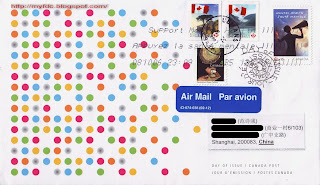 Canada FDC
Canada FDC
Name: Mental Health (Semi-postal Stamp)
Date of Issue: 06 October 2008
One in five Canadians will experience some form of mental illness over the course of their lives. Many more will be affected by the illness of a family member, friend or colleague. Today, mental health issues are beginning to be addressed with greater understanding and less fear, an approach that is increasing access to treatment and diminishing the stigma of mental illness. The release of this semi-postal stamp coincides with Mental Illness Awareness Week, which aims to shed light on the many challenges faced by those dealing with the impact of mental illness. While much progress has been achieved, there still is much to be done to ensure that all Canadians living with mental illness have the resources and support to lead fuller and more independent lives. This is why mental health is Canada Post's Cause of Choice – and why we have initiated the Canada Post Foundation fro Mental Health.
The digitally-enhanced photograph on the stamp features a figure stepping out of the shadows, using a mega-phone to broadcast the plight of mental health patients. The stamp cancellation site will be Ottawa, as the city is home to the Foundation's headquarters.
Comment: This is the 3rd series semi-postal stamps in Canada history. The 1st series were issued between 1974 and 1976 to support the Olympic Games in Montreal, and the 2nd series was issued in 1996 to support literacy in Canada.
Posted by Fan Ming at 10/21/2008 07:11:00 AM
![]() 0
Comments
Label:
Canada
0
Comments
Label:
Canada
Monday, October 20, 2008
Malaysia Flowers FDC

 Malaysia FDC
Malaysia FDC
Name: Unique Flowers
Date of Issue: 09 October 2008
There are many varieties of flowers found in Malaysia and there are some species that are attractive and unique due to their special shape or rare fragrance. Most traditional Malay landscape comprise of plants with fragrant flowers, leaves and wood. In fact, most traditional poetry refers to these unique traits.
The issuance of this Unique Flower stamps is an effort to increase the awareness of such flowers as well as to popularize Malaysian flowers
Denominations:
30 sen: Kenerak (Goniothalamus tapis)
Kenerak is a shrub or small tree up to 3 metres high with ascending branches and shot twigs forming conical or uneven crown. Leaves are oblong in shape, widest near apex and bluntly tipped, 12 - 24 cm long, 6 – 11 cm wide, dull yellow green. Flowers grow solitary on leaf twigs hanging from short stalks. Calyx is green in colour, and outer petals are cream white or pale yellowish and very fragrant. The fruits are ellipsoid, 1.2 cm long, red in colour and turn purplish black as it ripens.
Kenerak is often planted in Malay villages, especially in Kelantan and Terengganu. The flowers are often sold in the markets.
30 sen: Climbing Lily (Gloriosa superba)
This plant is a species of lily that climbs up to 2.5 metres in height, aided by tendril-like tips at the of its narrow lanceolate shaped leaves. The flowers are attractive and unique with narrow yellow and red curly edged petals. When it blooms, the flower turns inside out and points upwards, with the stamens and pistil more or less horizontal. The plant has underground bulb which is poisonous.
The plant is cultivated in Malaysian gardens for its unique and attractive flowers. Malays call it Bunga Kembang Songsang because when the flowers fully bloom the petals grow inverted.
50 sen: Rangoon Creeper (Quisqualis indica)
Rangoon Creeper is a climbing shrub and planted as ornamental plant because of its unique flowers. It can also be found growing wild, escaped from cultivation. The flowers are very attractive and borne in short clusters. The flower tube is 5 cm long and the petals are white but turn to red when matured. The flower blooms at night and are very fragrant.
The plant is often planted as climber on fences, on specially prepared pergola or left to climb on big trees.
50 sen: Banana Shrub (Michelia figo)
The shrub is about 1 – 2 metres high, branched to form bush-shaped canopy. The leaves are elliptical in shape, 5 – 10 cm long, 2 – 6 cm wide, with short petiole, and dark green in colour. The flowers are about 3-4 cm in diameter when fully opened, the bracts are brownish and hairy, and the petals are yellowish white with slightly purplish base. The flowers are fragrant reminiscent of banana. In Malaysia the plant seldom bear fruits.
The Chinese community uses the flowers to fragrant tea and the Malays use the flowers in aromatic bath and potpourri.
Comment: Because Malaysia situates in tropics, they have many unique flowers, but you should be a flower expert, otherwise you don't know how to relish them.
2008 Malaysia Unique Flowers FDC
2008 Malaysia Unique Flowers Souvenir Sheet FDC
Posted by Fan Ming at 10/20/2008 07:12:00 AM
![]() 0
Comments
Label:
Malaysia
0
Comments
Label:
Malaysia
Sunday, October 19, 2008
Canada Animals FDC

 Canada FDC
Canada FDC
Name: Endangered Species
Date of Issue: 01 October 2008
Denominations:
52c: Prothonotary Warbler (Protonotaria citrea)
Named for the yellow vestments of the pope's legal advisor, the Prothonotary Warbler has a golden head and breast, blue-grey wings and a black tail. The few that remain of this species can be seen along Lakes Erie and Huron.
52c: Taylor's Checkerspot (Euphydryas editha taylori)
Found in Canada in a single location on southeastern Vancouver Island, British Columbia, the Taylor's Checkerspot owes its name to its colour patterns. these small to medium-sized butterlies are weak flyers that seldom stray far from the plants they eat.
52c: Roseate Tern (Sterna dougallii)
Smaller than a gull, the Roseate Tern is distinguished by its forked tail and black bill and cap. Noted for speed and manoeuvrability, this East Coast bird beats its wings rapidly and calls persistently.
52c: Burrowing Owl (Athene cunicularia)
The only owl to live in burrows and hunt both day and night, the Burrowing Owl is found in the prairie regions of Alberta and Saskatchewan.
Comment: This is my first imperforated self-adhesive stamps FDC, although this is a antitraditional materials. But I think it will be the popular trends, we will see many imperforated self-adhesive stamps in the future.
Posted by Fan Ming at 10/19/2008 08:26:00 AM
![]() 1 Comments
Label:
Canada
1 Comments
Label:
Canada
Saturday, October 18, 2008
Russia Ustinov PCBCS
 Russia PCBCS (Post Cards Bearing Commemorative Stamp)
Russia PCBCS (Post Cards Bearing Commemorative Stamp)
Name: The 100th Birth Anniversary of Dmitriy Ustinov
Date of Issue: 25 September 2008
Dmitriy Fyodorovich Ustinov (Russian: Дми́трий Фё́дорович Усти́нов) (October 17, 1908–December 20, 1984) was Minister of Defense of the Soviet Union from 1976 until his death.
Dimitry Fyodorovich Ustinov was born in Samara to a working-class family. In the civil war, when hunger became intolerable, the entire family headed by Fyodor, his sick father went to Samarkand, which served as his elder brothers. Short time after that, in 1922, his father died. In 1923, together with his mother, he moved to the city of Makarev (near Ivanovo-Voznesensk) where he worked as a fitter in a paper mill. Shortly after, in 1925 his mother, Yevrosinya Martinovna died. More...
Posted by Fan Ming at 10/18/2008 07:28:00 PM
![]() 0
Comments
Label:
Russia
0
Comments
Label:
Russia
Friday, October 17, 2008
Lithuania Coats of Arms FDC
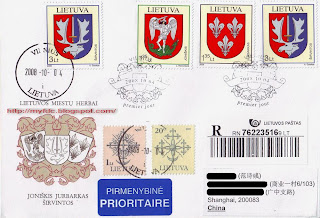 Lithuania FDC
Lithuania FDC
Name: Coats of Arms of Lithuania Towns
Date of Issue: 04 October 2008
Denominations:
1.35 Lt: Joniškis
The year 1523 is considered to be the date of Joniškis foundation, when the residents of the suburbs of Šiauliai rural district, being pagans, were baptized by the order of Vilnius Bishop John. Parishes were established in some settlements and one of them was named Joniškis. In 1526, a church was built in the settlement, and the year 1530 marks the opening of a primary school.
In 1616, Joniškis was granted the Magdeburg Rights and seal depicting St. Michael holding a sword. St. Michael is also depicted in the emblem of Joniškis.
1.35 Lt: Jurbarkas
For the first time Jurbarkas was mentioned in 1259 in the Chronicle of Peter of Dusburg when the Livonian Knights built the Georgenburg Castle. In 1430, a church was built in Jurbarkas. The rural district of Jurbarkas was mentioned in 1502; in 1611, the town was granted the Magdeburg Rights and emblem depicting three white lilies in a red shield.
Jurbarkas is famous for the longest transport bridge (496 m) in Lithuania. The bridge across the river Nemunas connects Jurbarkas with the Šakiai district.
3 Lt: Širvintos
Širvintos are known from the end of the 14th century. According to the legend, the name of the town was given after the river Širvinta. In 1475, a church was built and in 1746, Širvintos received the right to hold markets. In the 17th – 18th centuries, Širvintos was the centre of the subdistrict, at the end of the 19th century – the centre of the rural district, and since 1950 – the district centre.
The emblem of Širvintos depicts the head of an elk with branched horns and a sword symbolizing battles with enemies.
Comment: Coat of Arms is very popular in Europe, "Coat of Arms of the region", "Coat of Arms of the city" and "Coat of Arms of the family". Do you have your family's Coat of Arms? I haven't. lol
Lithuania Coats of Arms Series FDCs:
Joniškis; Jurbarkas; Širvintos
Krekenava; Pakruojis; Šalčininkai
Posted by Fan Ming at 10/17/2008 06:18:00 AM
![]() 0
Comments
Label:
Lithuania
0
Comments
Label:
Lithuania
Thursday, October 16, 2008
Ukraine UKR-SWE Union FDC
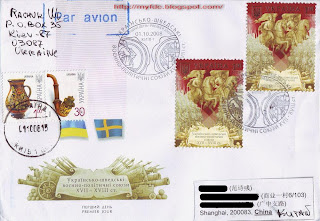 Ukraine FDC
Ukraine FDC
Name: Ukrainian - Swedish Military and Political Unions of XVII - XVIII Centuries
Date of Issue: 01 October 2008
Alliance with Bohdan Khmelnytsky
An alliance between Sweden and Hetman Bohdan Khmelnytsky against Poland was negotiated several times between 1651 and 1657. After the 1656 peace in Vilnius between Muscovy and Poland Hetman Bohdan Khmelnytsky was furiated and wrote to the tsar Alexis I of Russia: The Swedes are an honest people; when they pledge friendship and alliance, they honour their word. However, the Tsar, in establishing an armistice with the Poles and in wishing to return us into their hands, has behaved most heartlessly with us. Even after the Treaty of Pereyaslav in 1654 Hetman Bohdan Khmelnytsky continued to negotiate with the Swedes and in late 1655 his ambassador made proposals to the Swedish king Charles X Gustav to accept Ukraine as a Swedish vassal state and promised him the faithful service of the entire Zaporozhian Host.
Finally an agreement was signed between Sweden and three Ukrainian commanders (Ivan Bohun, the leader of the Ukrainian protestants Jerzy Niemirycz and Ivan Kovalyvsky) on October 6, 1657 in Korsun where Sweden acknowledged the Ukrainian borders all the way to Wisła in the west and Prussia in the north. But by then Bohdan Khmelnytsky had died one month earlier and after the Swedes had left Poland for military campaigns in Denmark the proposed alliance died.
Alliance with Ivan Mazepa
During the Great Northern War Sweden and Hetman Ivan Mazepa formed an alliance in 1708 against Peter I of Russia. But after the defeat at Poltava on June 28, 1709 parts of the Swedish army under king Charles XII and Hetman Ivan Mazepa together with his loyal cossacks had to flee to Bender in Ottoman Turkey where Mazepa soon died. Pylyp Orlyk was then chosen as a Hetman in exile by the cossacks and the Swedish king Charles XII. While in Bender Pylyp Orlyk wrote one of the first state constitutions in Europe. This constitutions was confirmed by Charles XII and it also names him as the protector of Ukraine. More...
Comment: If you have seen the fullsheet of this set, You will realize the background of this set more clearly, because there are 4 coupons in this fullsheet and depicts 4 important person and text. oh, but you should know Ukrainian at first, lol!
Posted by Fan Ming at 10/16/2008 07:35:00 AM
![]() 0
Comments
Label:
Ukraine
0
Comments
Label:
Ukraine
Wednesday, October 15, 2008
Thailand Letter Writing FDC
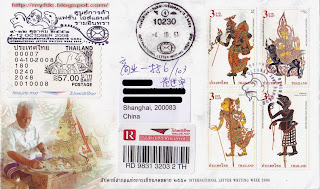 Thailand FDC
Thailand FDC
Name: International Letter Writing Week 2008
Date of Issue: 04 October 2008
Number: 855
Purpose:
To commemorate the 2008 International Letter Writing Week during 4-12 October 2008.
Designs: Illustrate the paintings which won prizes in the 206 International Letter Writing Week postage stamp painting competition, under the theme "Shadow Play".
3 บาท BAHT: Illustrates the rishi
3 บาท BAHT: Illustrates the shiva
3 บาท BAHT: Illustrates the shadow play preluder
3 บาท BAHT: Illustrates "Theng" the jester
Comment: It seems that Thailand Post always uses a special postmark during their "International Letter Writing Week". You could see the similar postmark on last year's FDCs, the only difference is the postcode, this time is "10230", but "10700" in 2007. I don't know whether they use it in only one post office or many post offices every year.
2008 Thailand International Letter Writing Week FDC
2007 Thailand International Letter Writing Week FDC
2007 Thailand International Letter Writing Week Minisheet FDC
Posted by Fan Ming at 10/15/2008 07:12:00 AM
![]() 0
Comments
Label:
Thailand
0
Comments
Label:
Thailand
Tuesday, October 14, 2008
Russia Helicopters FDC
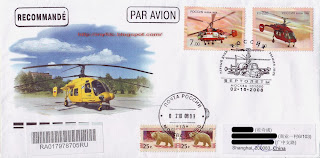 Russia FDC
Russia FDC
Name: Kamov's Helicopters
Date of Issue: 02 October 2008
Denominations:
7.00: Kamov Ka-27
The Kamov Ka-27 (NATO reporting name 'Helix') is a military helicopter developed for the Soviet Navy and currently in service in Russia, Ukraine, Vietnam, South Korea, China and India. The Ka-28 is a downgraded export version, while the Ka-32 is designed for civilian use. More...
7.00: Kamov Ka-226
The Kamov Ka-226 "Sergei" is a small, twin-engined Russian utility helicopter. The Ka-226 features an interchangeable mission pod, rather than a conventional cabin, allowing the use of various accommodation or equipment configurations. The Ka-226 entered service in 2002.
Since they shared a common lineage, all three of these helicopters have the NATO reporting name of Hoodlum, however Kamov's own name for the Ka-226 is Sergei. More...
Comment: I guess the helicopter on the speical cancellation is the "Kamov Ka-50", but I'm not sure. Who have any idea?
Posted by Fan Ming at 10/14/2008 07:05:00 AM
![]() 0
Comments
Label:
Russia
0
Comments
Label:
Russia
Monday, October 13, 2008
Thailand Korea Relation FDC
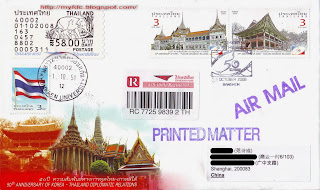 Thailand FDC
Thailand FDC
Name: 50th Anniversary of Korea - Thailand Diplomatic Relations (Pep. of Korea - Thailand Joint Issue)
Date of Issue: 01 October 2008
Number: 854
Purpose:
To publicize and to promote cooperation and cordial relation between Thailand and Republick of Korea on the 50th anniversary of diplomatic relations between the two countries.
Designs: Illustrate the resplendent palaces together with the emblem.
3 บาท BAHT: Chakri Maha Prasat Throne Hall, the Grand Palace
The modern central court is dominated by the curious Chakri Maha Prasat hall. The hall was built by King Rama V and completed in 1882. Its unusual design is due to some controversy during its construction. The original architect was a Briton working in Singapore named John Clunich. Rama V wanted an entirely western look to his new home, but others in the court argued that the king's residence and throne hall should reflect Siamese motifs. Thus the domed roof was replaced by a Thai styled roof. It should be no surprise that the Thai nickname for the building is the 'westerner with a Thai hat'. More...
3 บาท BAHT: Juhamnu Pavilion, Changdeokgung Palace
Juhamnu, or the Pavilion of Cosmic Union (Chinese: 宙合樓), looking over the Lotus Pond in the Secret Garden of Changdeok Palace, was constructed in 1776, the year King Jeongjo ascended the throne. The two-story pavilion and the pond create exquisite scenery. Jeongjo opened Gyujanggak, the Royal Library, on the first floor of the pavilion where eminent scholars engaged in academic research to promote civil rule. He named the pavilion Juhamnu, symbolizing the harmony of heaven and earth and the four cardinal directions, and wrote the sign himself. Buyongji, the square pond with a round islet, visualizes the ancient cosmic view that heaven is round and the earth is square. More...
Comment: I praise my friend's addtional stamp - Thai national flag stamp. It's an appropriate additional stamp on an appropriate FDC.
Posted by Fan Ming at 10/13/2008 06:58:00 AM
![]() 0
Comments
Label:
Joint Issue,
Thailand
0
Comments
Label:
Joint Issue,
Thailand
Saturday, October 11, 2008
Singapore F1 FDC
 Singapore FDC
Singapore FDC
Name: 2008 Formula 1 Singapore Grand Prix™
Date of Issue: 26 September 2008
Singapore will host the world's first Formula 1™ night race on 28 September 2008. The inaugural 2008 Formula 1 SingTel Singapore Grand Prix™ will roar into town on a street circuit of public roads around the Marina Bay are - right in the heart of Singapore. Set against the backdrop of downtown Singapore, spectators will get a view of the garden city as the circuit winds past historic landmarks such as City Hall and modern buildings along the Marina Bay, such as the Esplanade.
The proposed 5.067km long circuit offers multiple overtaking opportunities, fast and challenging turns and grueling sections that will test the capabilities of the F1 drivers. The Race is most unique in a way that it enjoys so many firsts – it is the first ever Formula 1™ night race, Asia's first Formula 1™ street race and Singapore's first Formula 1™ race. In addition, it is one of the three circuits in the 2008 Formula 1™ calendar that turns anti-clockwise.
Comment: This is my first F1 real posted FDC. :)
Posted by Fan Ming at 10/11/2008 09:02:00 PM
![]() 1 Comments
Label:
Singapore
1 Comments
Label:
Singapore
Friday, October 10, 2008
My FDC on US Magazine (Mekeel's & Stamps)
Magazine Name: Mekeel's & Stamps
OCTOBER 10, 2008
Vol. 203, No. 25 Whole No. 6,143
Page: 10
Author: Amanda Gaukstern
 Link to this FDC
Link to this FDC
2008 Hong Kong Jellyfish Self-Drawing FDC
My FDCs on US Magazine
The Brookman Times
Mekeel's & Stamps
Posted by Fan Ming at 10/10/2008 06:38:00 PM
Estonia Kanter FDC
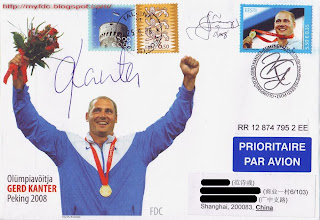
 Estonia FDC
Estonia FDC
Name: Gerd Kanter - Olympic Gold Medallist
Date of Issue: 25 September 2008
After the issue of the first Estonian postage stamp dedicated to an Olympic winner (Erki Nool in decathlon in Sydney, 2000) we had to wait eight long years before the next stamp devoted to an Estonian winner of Olympic summer games could be brought out. In the intervening years the skiers Andrus Veerpalu and Kristina ©migun brought honour and fame to Estonia and earned the issue of one stamp in 2002 and three in 2006. From the discus final taking place in front of the full house of the Beijing Olympic stadium on August 19, 2008 Estonian sports fans expected a medal from the previous year's world champion, Gerd Kanter and Gerd didn't disappoint them, sending his discus one meter farther in the fourth round than his main rivals Piotr Malachowski from Poland and Virgilijus Alekna from Lithuania. Before the Games the Lithuanian was regarded as one of Kanter's most serious rivals. By his feat he took his place in the line of such legendary discus-throwers as Al Oerter, Jürgen Schult, Lars Riedel and Virgilijus Alekna.
Comment: This is my best FDC in my real posted collection. I like it very much. This set dedicates to 2008 Beijing Olympic Games Gold Medalist - Gerd Kanter, do you find Gerd Kanter's autograph on this FDC? and the stamp's designer, Lembit Lõhmus, also signed his name on this FDC.
Estonia 2008 Beijing Olympic Games Gold Medalist Autographed FDC
Estonia 2008 Beijing Olympic Games Silver Medalists Autographed Postal Stationery
2008 Beijing Olympic Games FDCs:
Algeria, Belarus, Canada, Czech Republic, Estonia, Estonia Sheetlet, Great Britain, Hong Kong, Hong Kong M/S, Indonesia, Israel, Italy, Latvia, Lithuania, Philippines, Poland, Portugal, Portugal M/S, Romania, Russia, Singapore, Slovakia, Sri Lanka, Turkey, Ukraine.
2008 Beijing Paralympic Games FDCs:
Czech Republic, Slovakia.
Posted by Fan Ming at 10/10/2008 07:08:00 AM
![]() 0
Comments
Label:
2008 Olympic Games,
Estonia
0
Comments
Label:
2008 Olympic Games,
Estonia
Thursday, October 9, 2008
Estonia Rowers Postal Stationery
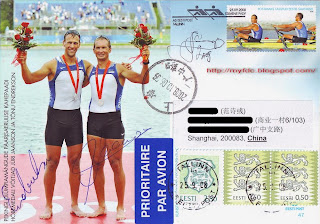 Estonia Postal Stationery
Estonia Postal Stationery
Name: Olympic Silver Medallists Jüri Jaanson and Tõnu Endrekson
Date of Issue: 25 September 2008
In 2008 Beijing Olympic Games, Estonian rowing legend Jüri Jaanson and Tõnu Endrekson competed in the double sculls event. The duo was third in their preliminary heat. In the semi-finals the men were second and assured themselves a place in the Final A. They finished second in the final just 0,05 seconds in front of the British duo Matthew Wells and Stephen Rowbotham.
Comment: This is my best Postal Stationery in my real posted collection. It has three autographes on this postcard, there are Endrekson (left), Jaanson (middle) and designer Lembit Lõhmus (right).
Estonia 2008 Beijing Olympic Games Gold Medalist Autographed FDC
Estonia 2008 Beijing Olympic Games Silver Medalists Autographed Postal Stationery
2008 Beijing Olympic Games FDCs:
Algeria, Belarus, Canada, Czech Republic, Estonia, Estonia Sheetlet, Great Britain, Hong Kong, Hong Kong M/S, Indonesia, Israel, Italy, Latvia, Lithuania, Philippines, Poland, Portugal, Portugal M/S, Romania, Russia, Singapore, Slovakia, Sri Lanka, Turkey, Ukraine.
2008 Beijing Paralympic Games FDCs:
Czech Republic, Slovakia.
Posted by Fan Ming at 10/09/2008 07:05:00 AM
![]() 0
Comments
Label:
2008 Olympic Games,
Estonia
0
Comments
Label:
2008 Olympic Games,
Estonia
Wednesday, October 8, 2008
Italy Library FDC

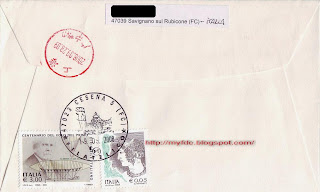 Italy FDC
Italy FDC
Name: Malatestiana Library
Date of Issue: 19 September 2008
It features details from the interior of Malatestiana Library in Cesena, which was designed in 1452 by an architect from Fano, Matteo Nuti, for the city's Lord Novello Malatesta. More...
Comment: Italy FDC never has beautiful illustration and is always small size, so it's hard to glue all of the valid materials (registered label, additional stamps etc.) on the face side.
Posted by Fan Ming at 10/08/2008 07:11:00 AM
![]() 1 Comments
Label:
Italy
1 Comments
Label:
Italy
Tuesday, October 7, 2008
China Stamp: 2008-26
Name: The 50th Anniversary of the Guangxi Zhuang Autonomous Region
Number: 2008-26
Date of Issue: 18 October 2008
Value: 3 stamps/set
Denominations:
80 Fen (3-1): Song of Joy
1.20 Yuan (3-2): Cooperation
1.20 Yuan (3-2): Development
Guangxi (or Guangxi Zhuang Autonomous Region; simplified Chinese: 广西壮族自治区; traditional Chinese: 廣西壯族自治區; pinyin: Guǎngxī Zhuàngzú Zìzhìqū) is a Zhuang autonomous region of the People's Republic of China.
Its location in southern China, along its border with Vietnam, and mountainous terrain, has made it one of the border frontiers of Chinese civilization. Even into the 20th century it was considered an open, wild territory. The current name "Guang" itself means "expanse", and has been associated with the region since the creation of Guang Prefecture in 226 AD. It was given provincial level status during the Yuan Dynasty and in 1949 was reformed as one of China's five minority autonomous regions.
The abbreviation of the province is 桂 (Gui), which comes from Guilin, former capital, center of much of Guangxi's culture, politics, and history, and currently a major city in the autonomous region.
Being in the far south, Guangxi was not taken by communist forces until after the People's Republic was formed; it joined in December 1949, two months after the People's Republic's foundation. In 1958, Guangxi was converted into an autonomous region for the Zhuang, by recommendation of Premier Zhou Enlai. This decision was made because the Zhuang were one of the biggest minority groups in China, and were mostly concentrated in Guangxi; however, they form a minority of Guangxi's population. More...
Posted by Fan Ming at 10/07/2008 03:33:00 PM
![]() 0
Comments
Label:
China
0
Comments
Label:
China
Indonesia Provincial Emblems FDCs (I)
Indonesia FDCs Bali Province Gorontalo Province West Java Province Center Java Province West Kalimantan Province Maluku Province Nanggroe Aceh Darussalam Province Papua Province Riau Province West Sulawesi Province West Sumatra Province
Name: Provincial Emblems (1st Series)
Date of Issue: 17 August 2008
Comment: As you see, every design has two different denominations. The 1500 one comes from the fullsheet and the 2500 one comes from the Minisheet. If you observe them carefully, you will find the printing colors are differences.
Posted by Fan Ming at 10/07/2008 07:10:00 AM
![]() 0
Comments
Label:
Indonesia
0
Comments
Label:
Indonesia

